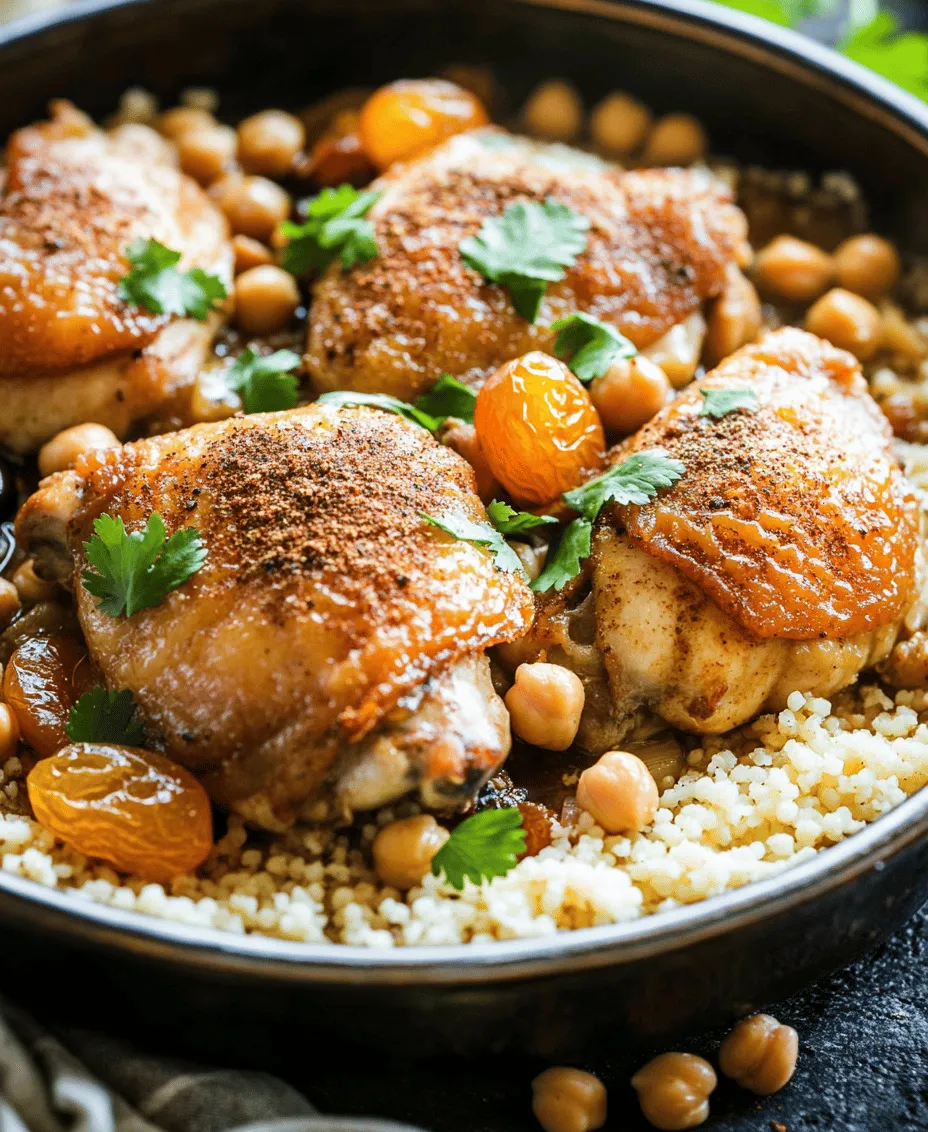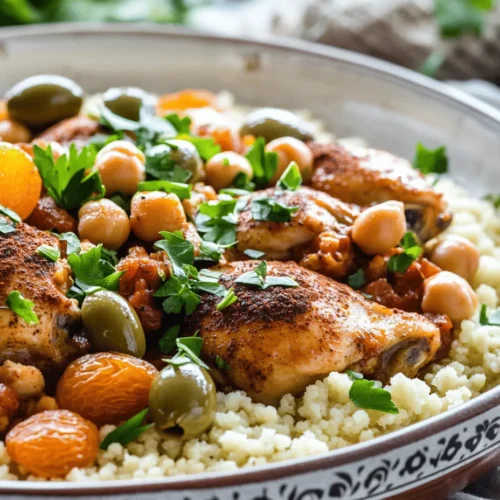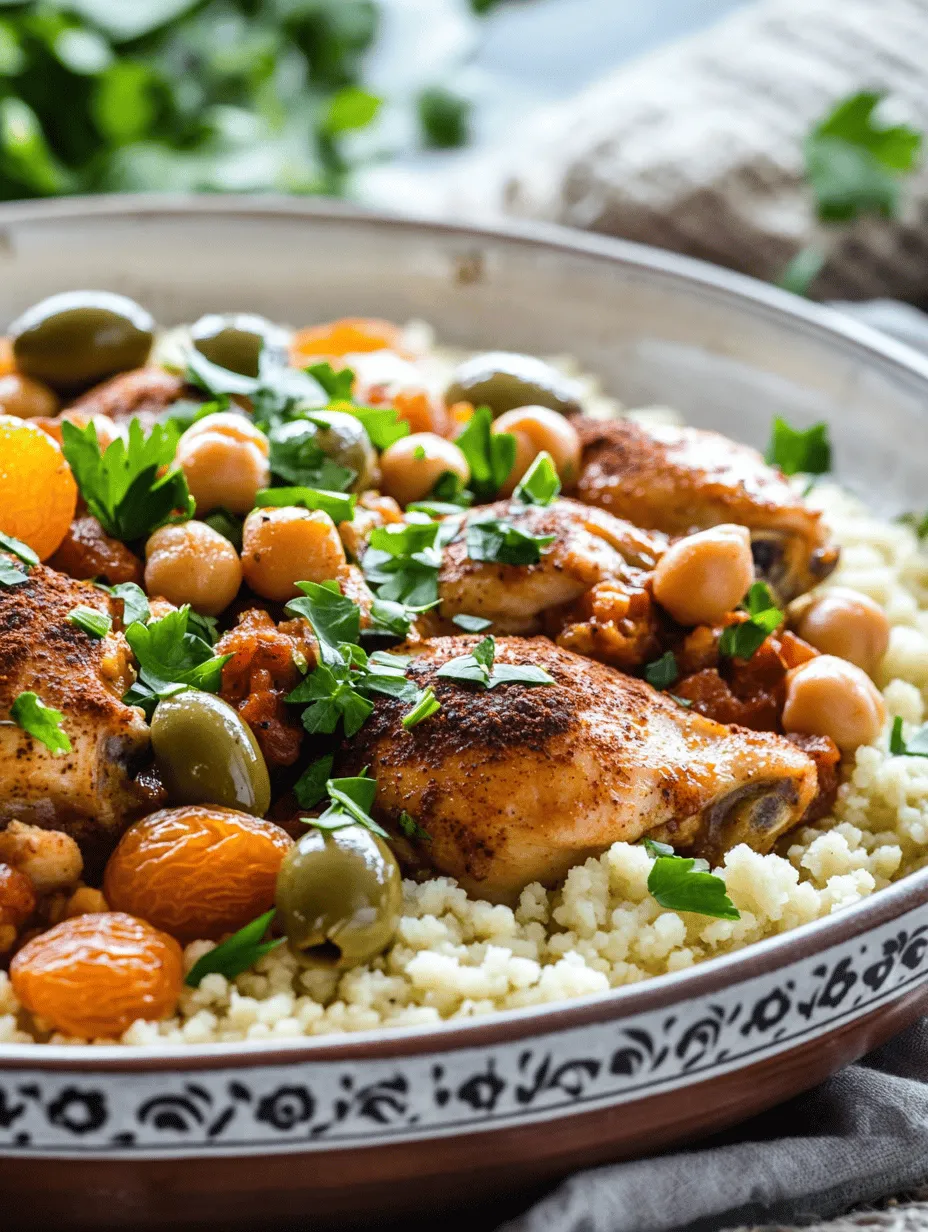Introduction
Embark on a culinary adventure to North Africa with our Savory Chicken Tajine paired with Fluffy Couscous. This exquisite dish marries the rich flavors and aromas of traditional Moroccan cuisine, showcasing the region’s vibrant ingredients and time-honored cooking techniques. The tajine is not just a meal; it’s a cultural experience, steeped in history and communal dining practices that celebrate togetherness and hospitality.
Originating from the Berber people of Morocco, the tajine is named after the earthenware pot in which it is traditionally cooked. The pot’s conical shape allows steam to circulate, creating a unique cooking environment that yields tender, flavorful dishes. Tajines are an integral part of North African cooking, serving as a canvas for a variety of ingredients, from meats to vegetables, all enriched with aromatic spices that evoke the warmth of the region’s sun-drenched markets.
In this recipe, you will discover a harmonious balance of flavors and textures, where succulent chicken thighs mingle with the sweetness of dried apricots, the creamy richness of chickpeas, and the briny notes of olives. The dish is completed with fluffy couscous, a staple in North African cuisine that not only complements the tajine but also serves as a cultural symbol representing nourishment and community.
Understanding Tajine Cooking
At the heart of this delightful dish lies the tajine pot itself, a culinary tool that is both functional and symbolic. A tajine consists of two parts: a shallow, circular base and a tall, conical lid. This design is integral to the cooking process, as it allows moisture to condense and drip back into the dish, ensuring that the ingredients remain juicy and flavorful. The slow cooking method associated with tajine preparation is key to developing deep, complex flavors while tenderizing tougher cuts of meat.
The slow cooking process not only enhances the taste but also preserves the nutrients within the ingredients. As the chicken and vegetables simmer together, their flavors meld into a rich, aromatic sauce. This method also allows the spices to infuse the dish thoroughly, creating a depth of flavor that is characteristic of Moroccan cuisine.
Common ingredients found in traditional tajine dishes include a variety of meats, vegetables, dried fruits, nuts, and an array of spices. The spices used in tajine cooking are central to its identity, transforming simple ingredients into a feast for the senses. Cumin, coriander, cinnamon, paprika, and cayenne pepper are often the stars of the show, each contributing unique flavors and aromas that transport you to the bustling streets of Marrakech or the serene landscapes of the Atlas Mountains.
Ingredients Breakdown
To create a truly authentic Savory Chicken Tajine with Fluffy Couscous, let’s delve into each ingredient and its role in this exquisite dish.
Chicken Thighs
For this recipe, we recommend using bone-in, skinless chicken thighs. This choice is strategic; the bone adds flavor and moisture during cooking, while the skinless option allows the spices and sauce to penetrate the meat more effectively. Chicken thighs are also tender and juicy, making them ideal for slow cooking. Unlike chicken breasts, they retain their moisture and flavor, ensuring that every bite is succulent and delicious.
Olive Oil
Olive oil is the fat of choice in this recipe, not only for its health benefits but also for its rich flavor profile. It is heart-healthy, packed with antioxidants, and adds a smooth richness to the dish. The use of high-quality extra virgin olive oil can elevate the overall taste, enhancing the aromatic spices and balancing the dish’s flavors.
Aromatics
Onions and garlic are essential aromatics that lay the foundation for flavor in this tajine. Onions add sweetness and depth, while garlic provides a pungent, savory note that complements the spices beautifully. Properly sautéing these ingredients releases their natural sugars and enhances their flavors, ensuring a robust base for the dish.
Spices
A well-balanced blend of spices is what makes this tajine truly remarkable. The following spices play a crucial role:
– Cumin: Known for its warm, earthy flavor, cumin is a staple in North African cuisine. It aids digestion and boasts anti-inflammatory properties.
– Coriander: With its citrusy notes, coriander enhances the dish’s freshness. It is also known for its antioxidant qualities.
– Cinnamon: Often associated with sweetness, cinnamon adds warmth and depth, rounding out the spice blend beautifully.
– Paprika: This spice contributes a subtle smokiness and a vibrant color, making the dish visually appealing.
– Cayenne: For those who enjoy a bit of heat, cayenne pepper adds a spicy kick, elevating the overall flavor profile.
Chickpeas and Dried Apricots
Chickpeas are a nutritional powerhouse, packed with protein and fiber. They add a creamy texture that contrasts beautifully with the tender chicken. Dried apricots introduce a touch of sweetness to the dish, balancing the savory flavors and enriching the overall experience. Together, these ingredients create a delightful interplay of textures and tastes.
Olives and Lemon
The addition of olives brings a salty, briny flavor that complements the sweetness of the apricots. Green olives, often used in Moroccan cooking, provide a burst of flavor that enhances the dish’s complexity. Fresh lemon juice adds acidity, brightening the dish and balancing the richness of the chicken and oil.
Couscous
Couscous is a staple grain in North African cuisine, traditionally made from semolina wheat. With its light and fluffy texture, couscous serves as the perfect accompaniment to tajine, soaking up the flavorful sauce and providing a satisfying contrast to the tender chicken. There are various types of couscous, but for this recipe, we recommend using medium-sized couscous, as it cooks quickly and absorbs flavors exceptionally well.
Step-by-Step Cooking Instructions
Browning the Chicken
To achieve the perfect sear on the chicken, start by heating olive oil in the tajine or a heavy-bottomed pot over medium-high heat. Season the chicken thighs generously with salt and pepper, then add them to the pot, skin-side down. Allow the chicken to brown undisturbed for about 5-7 minutes, or until a golden crust forms. This step is crucial, as it develops flavor through the Maillard reaction, which creates a rich, savory base for the dish. Once browned, remove the chicken from the pot and set it aside.
Sautéing Aromatics
In the same pot, add diced onions and minced garlic. Sauté them over medium heat for about 5 minutes, stirring occasionally, until the onions become translucent and fragrant. This step allows the onions to release their sweetness and the garlic to mellow, creating a flavorful base for the tajine. Once the onions are softened, add the spices—cumin, coriander, cinnamon, paprika, and cayenne—stirring well to coat the onions and garlic. Cooking the spices briefly in oil helps to unlock their essential oils, intensifying their flavors.
Mixing Spices
After the spices have been added, return the browned chicken to the pot, nestling it among the sautéed aromatics. Pour in a mixture of chickpeas, dried apricots, olives, and a splash of water or chicken broth. The liquid should cover the chicken about halfway, allowing it to braise gently. Squeeze in the juice of a fresh lemon, adding brightness and depth to the dish. Bring the mixture to a simmer, then cover the pot with the tajine lid (or a regular lid if using a different pot) and reduce the heat to low. Allow the tajine to cook slowly for 45 minutes to an hour, or until the chicken is tender and cooked through, absorbing the rich flavors of the sauce.
By following these steps, you’ll set the stage for a truly authentic and flavorful dish that exemplifies the heart of North African cooking. The combination of spices, slow-cooked chicken, and the delightful pairing with fluffy couscous is bound to impress anyone fortunate enough to share in this culinary experience. Prepare to transport your taste buds to the vibrant markets and warm kitchens of Morocco with this Savory Chicken Tajine.

Simmering the Tajine
To achieve a tender, flavorful chicken tajine, temperature control and simmering time are of utmost importance. After searing the chicken and adding your aromatic spices, vegetables, and broth, bring the mixture to a gentle boil over medium heat. Once it reaches a boiling point, reduce the heat to low, ensuring a slow and steady simmer. This method allows the chicken to cook evenly and absorb all the rich flavors from the spices and vegetables.
A good tajine should simmer for at least 45 minutes to an hour, depending on the size of the chicken pieces. This extended cooking time breaks down the connective tissues in the meat, resulting in a succulent and tender texture that practically falls off the bone. Additionally, keep the lid tightly closed during simmering to trap the steam and moisture, which also contributes to the dish’s overall flavor.
Throughout the cooking process, check occasionally to ensure that there is enough liquid in the tajine. If it appears to be drying out, add a splash of water or broth to maintain moisture. The goal is to create a rich, thick sauce that can be spooned over the fluffy couscous later on.
Preparing Fluffy Couscous
Achieving perfectly fluffy couscous is essential to complementing the savory chicken tajine. Here’s how to prepare it step-by-step:
1. Measure the Couscous: Start with 1 cup of couscous, which typically serves about four people.
2. Boil Water: In a medium saucepan, bring 1 1/4 cups of water to a boil. You can infuse the water with flavor by adding a pinch of salt and a drizzle of olive oil.
3. Add the Couscous: Once the water reaches a rolling boil, add the couscous and stir quickly to combine. Remove the saucepan from heat immediately after stirring.
4. Cover and Steep: Cover the saucepan tightly with a lid and let it sit for about 5 minutes. This resting period allows the couscous to absorb all the liquid.
5. Fluff with a Fork: After 5 minutes, uncover the saucepan and use a fork to gently fluff the couscous. This action separates the grains and prevents clumping.
6. Add Flavor: For an extra touch, consider mixing in a bit of melted butter, olive oil, or fresh herbs like parsley or cilantro at this stage. These additions enhance the flavor profile of the couscous and make it even more delicious.
Flavor Profiles and Pairings
The flavor profile of a chicken tajine is a vibrant tapestry of spices and aromatics. The warm spices such as cumin, coriander, and cinnamon, along with the brightness of lemon and the sweetness of dried fruits like apricots or raisins, create a balanced taste that is both comforting and exotic. The tenderness of the chicken absorbs these flavors beautifully, while the broth becomes a savory sauce that ties everything together.
To complement this dish, consider serving it with a simple salad of mixed greens dressed with lemon vinaigrette, which adds a refreshing contrast to the rich flavors of the tajine. Roasted vegetables, such as carrots, zucchini, or bell peppers, also pair nicely, maintaining the Moroccan theme while adding color and nutrition to your meal.
For beverages, Moroccan mint tea is a classic choice that enhances the dining experience with its sweet, fragrant notes. If you’re looking for something non-caffeinated, a light, fruity, and mildly spiced herbal tea can also be delightful.
Variations of the Recipe
While this chicken tajine recipe is hearty and satisfying, there are numerous ways to adapt it to suit different dietary preferences. For a vegetarian twist, replace the chicken with hearty vegetables such as eggplant, zucchini, and bell peppers, along with chickpeas for protein. Maintain the same aromatic spices and cooking method, allowing the vegetables to absorb the flavors of the broth.
Another option is to use fish or seafood in place of chicken. Firm white fish or shrimp can be cooked in a similar manner, with shorter cooking times to prevent overcooking. The tajine can also be made with lamb or beef, offering a richer flavor profile.
For those following a gluten-free diet, substituting couscous with quinoa or rice provides a great alternative that still delivers a fluffy texture to accompany the tajine.
Cultural Significance of Tajine and Couscous
Tajine is more than just a dish in Moroccan culture; it represents a communal style of eating that is deeply rooted in tradition. Family gatherings and celebrations often center around tajine dishes, where everyone shares from a communal plate, fostering a sense of togetherness and hospitality.
Couscous, often referred to as “the king of grains,” holds a similar cultural significance. Traditionally served in large bowls, it is often accompanied by a variety of stews, vegetables, and meats. In North African households, couscous is prepared on special occasions, such as weddings and religious celebrations, symbolizing abundance and prosperity.
Family stories often revolve around the preparation of these dishes, passed down through generations. The act of cooking together becomes a cherished memory, as families gather to share not just food, but laughter and love.
Serving Suggestions
When it comes to presenting your chicken tajine and fluffy couscous, the goal is to create an inviting and authentic North African dining experience. Start by placing the tajine in the center of the table, allowing guests to serve themselves.
For an elegant touch, you can serve the couscous in a separate bowl, garnished with fresh herbs like cilantro or parsley. Consider adding a sprinkle of toasted almonds or pine nuts for an added crunch and visual appeal.
To enhance the authentic North African flair, use decorative serving dishes and utensils. Traditional tajine pots, with their conical lids, not only serve a functional purpose but also add a beautiful aesthetic to your table setting.
Garnish the finished dish with fragrant herbs and spices, such as a dusting of ground cinnamon or a sprig of fresh mint. These final touches not only elevate the presentation but also hint at the tantalizing flavors waiting to be enjoyed.
Nutritional Information
The nutritional benefits of this savory chicken tajine with fluffy couscous are significant. Chicken is an excellent source of lean protein, which is essential for muscle growth and repair. The addition of vegetables contributes essential vitamins, minerals, and dietary fiber, promoting overall health.
Couscous, made from whole wheat or semolina, provides carbohydrates for energy, along with some protein and fiber. When combined with vegetables and the flavorful broth from the tajine, this dish becomes well-rounded and satisfying.
For a typical serving of chicken tajine and couscous, you can expect around 450-550 calories, depending on portion sizes and additional ingredients like olive oil or nuts. The dish can be modified to suit health-conscious choices by using skinless chicken breast, reducing added fats, or increasing vegetable portions for added nutrients.
Conclusion
The savory chicken tajine with fluffy couscous is a delightful exploration of North African culinary traditions. Its rich flavors, comforting textures, and communal serving style make it a perfect dish for family gatherings or special occasions.
As you recreate this recipe in your kitchen, embrace the joy of cooking and sharing meals with loved ones. Allow the aromas of spices and simmering chicken to fill your home, inviting everyone to the table for a shared experience that transcends borders.
So why not try your hand at this Moroccan classic? Experience the warmth of its flavors, the history of its ingredients, and the joy of bringing people together through food. The world of culinary exploration awaits!



